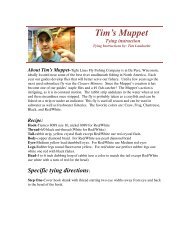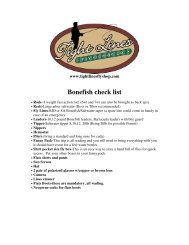30-41 Achigan - Tight Lines Fly Fishing Co.
30-41 Achigan - Tight Lines Fly Fishing Co.
30-41 Achigan - Tight Lines Fly Fishing Co.
You also want an ePaper? Increase the reach of your titles
YUMPU automatically turns print PDFs into web optimized ePapers that Google loves.
<strong>30</strong>-<strong>41</strong> <strong>Achigan</strong> 6/19/06 7:32 PM Page 38<br />
T A C K L E T I P S<br />
Gearing Up for Smallmouths<br />
PICK A MEDIUM-FAST OR FAST-ACTION NINE-FOOT 8-WEIGHT<br />
for your first smallmouth rod. The heavy line allows for easy casting<br />
of heavy or wind-resistant flies and quick landing of a strong<br />
fish in current. Six and 7-weight rods certainly have their place in<br />
smaller streams and also in clear, shallow water typical of late<br />
summer, so keep those in mind for those conditions.<br />
I prefer fast action rods (but not too stiff) and haven’t used anything<br />
better than the Sage XP. They cast well in the range of <strong>30</strong> to<br />
60 feet and have strong butt sections. Other folks certainly make<br />
excellent fly rods, just make sure you test cast with a fly when it’s<br />
time to buy.<br />
You don’t need a stop-a-truck drag for bass, but reel weight is<br />
more important than you think. Casting a tip heavy 8-weight will<br />
lead to arm and hand pain. Pick a reel that balances your rod<br />
roughly at the position of your index finger and thumb.<br />
If money is tight, get a good rod and workman reel. If your wallet<br />
is more forgiving, consider that your new 8-weight will be ideal<br />
for steelhead and bonefish—assuming you have a reel with a quality<br />
drag. Buy the best reel you can. Ross Canyon reels are proven<br />
big fish performers. The Cadillacs are still Tibor and Abel.<br />
I plead shameless endorsement for Rio fly lines. The Clouser is<br />
the best bass line that I’ve used. Its turns over bulky flies easily and<br />
shoots well. Rio uses the Clouser taper in several other lines useful<br />
for bass fishing.<br />
My favorites are their short-head (seven to nine and a half-foot)<br />
intermediate, type 3, and type 6 sink-tip lines (look for Streamer Tip<br />
and Density <strong>Co</strong>mpensated Sinking Tip). They’re ideal for shallow<br />
rivers. I use the intermediate clear-tip line often. Its slow sink rate is<br />
perfect for fishing streamers over submerged bars, shelves and humps.<br />
Flies connected to floating lines are best served by a standard<br />
eight or nine-foot leader tapered to eight, 10 or 12-pound tippet. If<br />
you tie your own, there are plenty of published formulas to pick<br />
from. Sink-tip lines work fine with a three- to five-level leader.<br />
Regular mono is good most of the time, but fluorocarbon has its<br />
place, especially in low, clear water. I’ve used mostly Umpqua and<br />
Rio tippet, but I’m also impressed with Frog Hair; although expensive,<br />
it really is supple, stretchy and strong.<br />
Tie on your flies with the non-slip loop knot. It is strong, quick<br />
and easy to tie—and most importantly, allows the fly to move<br />
freely. Practice tying the loop small; big loops cause tangles. Check<br />
your leader and knots frequently.<br />
Casting a big fly rod, especially with heavy flies and sink tips,<br />
isn’t easy. Take a couple of lessons, and practice regularly. Focus<br />
on basic casting, but also mending, shooting line, casting under<br />
obstacles (branches) and accuracy.<br />
Two skills poorly developed in many anglers are hook setting and<br />
fish fighting. Have someone show you how to strip-strike properly.<br />
Most people use far too little force and wonder why they lose<br />
fish—they never did set the hook. There is a lot of stretch in a fly<br />
line, and 10-pound tippet is strong stuff.<br />
It takes skill to land a strong fish quickly, and keep in mind that<br />
the “Orvis Pose” is a bunch of b.s.—it’s a great way to break a rod.<br />
Keep the rod lower and closer to your body. You’ll tire a fish quickly<br />
by pulling the rod in the direction opposite to its run. One final<br />
thought—a good guide will show you how to fish as much as<br />
where to fish. Take advantage of that.<br />
Smallmouth bass are wily creatures, but can still be fooled by an expertly-placed leggy fly.<br />
also seldom saw big fish pictures—no<br />
22-inch monsters.<br />
I did catch fish, but not many and not<br />
anything big.<br />
Then I had an epiphany, mostly<br />
because I was just really tired one<br />
Saturday morning. A few years ago I<br />
accidentally watched ESPN one weekend<br />
and started reading In-Fisherman<br />
and Bassmaster.<br />
And to answer your question: No, I<br />
don’t have one of those fishing shirts<br />
that make me look like a NASCAR<br />
crew chief. But I suspect there is a flyfishing<br />
rep somewhere with visions of<br />
guides wearing Winston or Sage plastered<br />
across their shirts and embroidered<br />
flames thrown in for the new generation.<br />
What I noticed was the gear guys<br />
using tactics a lot more refined than<br />
things I’d seen in any fly fishing magazine.<br />
Granted, fishing deep with gear is<br />
more user-friendly than with fly tackle,<br />
but to be more successful as a smallmouth<br />
fisherman, I needed to nymph<br />
and sling sink tips more effectively and<br />
more often. Otherwise, my bass fishing<br />
It’s fishing those trenches that will make you look long and hard at spinning gear<br />
the next time you’re at a hook-and-bullet store.<br />
on both rods and waited. In the next 20<br />
minutes, my boat picked up two fish<br />
and his boated 12, while we were made<br />
to watch. In the afternoon heat the bass<br />
had moved up on to the shelf to feed on<br />
minnows, and they were happy to eat<br />
poppers as well.<br />
The lesson learned was: grasshoppers<br />
should never low-hole their masters.<br />
Weeding Out<br />
Weedy areas attract minnows and<br />
can harbor big bass. They can also be<br />
tough to fish with fly tackle; try surface<br />
and weedless patterns. Slower water<br />
downstream of riffles, larger drops to<br />
deep water, and the tails of pools can be<br />
productive. Occasionally<br />
you’ll need intermediate or<br />
deep-water lines and flies.<br />
Drowned or partiallysubmerged<br />
wood is a<br />
mixed bag. Isolated<br />
stumps or logs will often<br />
hold a fish or two in an<br />
MIKO ’ S M U D B U G<br />
PATTERN BY NELSON HAM<br />
TIED BY NELSON HAM<br />
HOOK: Eagle Claw 6<strong>30</strong>, size 1<br />
THREAD: Brown 6/0 Uni-Thread<br />
WEIGHT: Medium nickel-plated Dazl-eyes<br />
EYES: Black medium bead chain or burned<br />
mono; tied down bend from shank<br />
CLAWS: Two brown grizzly marabou plumes<br />
FEELERS/LEGS:<br />
Orange or yellow round rubber<br />
hackle; Flashabou and Krystal Flash<br />
to complement<br />
BODY: Brown grizzly, oversized saddle<br />
hackle; palmer over pearl-root beer<br />
Estaz<br />
NOTE: Plain lead eyes can be used, but harder<br />
dumbbell eyes create more sound when hitting<br />
underwater rocks. Most effective fished<br />
when stripped instead of nymphed.<br />
otherwise bleak stream bed.<br />
Some authors stress fishing the shady<br />
bank, but too many fish are caught in<br />
sun. <strong>Co</strong>ncentrate on structure and forage<br />
first, and then shade. Nonetheless,<br />
always cover water beneath overhanging<br />
trees.<br />
Honestly, if you’re fishing northern<br />
Wisconsin rivers for the first time, you<br />
would be blind to miss half the good<br />
structure. The islands, ledges, points,<br />
walls, humps and big boulders are obvious<br />
in the lower flows typical of late<br />
summer.<br />
Short of signs saying, “cast here,” the<br />
structure can’t be more accommodating.<br />
It’s some of the best smallmouth<br />
water in the country.<br />
But the other half River knowledge<br />
is hard won. There are still times when<br />
I fish with Tim or Bart on a river we all<br />
know, and invariably we catch a few<br />
more fish on “their side.”<br />
At its bleakest, fishing for smallmouths<br />
will make you think you’re<br />
hunting for the giant squid in an ocean<br />
trench. When the fish disappear there is<br />
only one place to go—deep with heavy<br />
flies and sink-tips. Gapen calls it “center-streaming.”<br />
The fly tackle is cumbersome,<br />
the casting is not really casting,<br />
the strikes are hard to detect and<br />
the fishing is slow.<br />
My advice to you: Good luck<br />
It’s fishing those trenches that will<br />
make you look long and hard at spinning<br />
gear the next time you’re at a<br />
hook-and-bullet store.<br />
The ESPN Epiphany<br />
When I first read about fishing for<br />
smallmouths, it<br />
seemed that I’d<br />
need poppers,<br />
a few crayfish<br />
patterns and<br />
roughly 500<br />
Clouser minnows—and<br />
the<br />
streamers should<br />
all be two-tothree<br />
inches long. I<br />
AVER Y A N C H O V Y<br />
PATTERN BY NELSON HAM<br />
TIED BY NELSON HAM<br />
HOOK: TMC 8089NP, size 10<br />
THREAD: Danville monofilament, ultrafine<br />
TAIL: Silver and pearl Flashabou, mixed<br />
BODY: Pearl Ice Wing Fiber or Gartside<br />
Secret Stuff or Martinek Dri Ice<br />
TOP: Smoke DNA Holo-Fusion<br />
EYES: Pearl or silver 3-D molded, size 5.0<br />
NOTE: Ice wing fibers are attached in alternating<br />
clumps until the head is reached, then<br />
brushed vigorously rearward with a dog<br />
brush. Flies up to six or eight inches long<br />
can easily be tied in combination with other<br />
tailing materials like feathers, Icelandic<br />
sheep fur or Puglisi fibers. Try fishing with<br />
a Petitjean Magic Minnow Head or<br />
Wigglefin.<br />
would be like dry-flies-only fishing for<br />
trout.<br />
All this led me to one magical<br />
thought:<br />
I wondered why we didn’t use flies as<br />
big as some of those bass lures.<br />
Have you measured a Zara Super<br />
Spook or looked lately at the size of<br />
most soft baits Three-to-six inches is a<br />
lot more common than two or three—<br />
and the largest swimbaits used today for<br />
targeting giant largemouths are almost<br />
a foot long!<br />
It was about this time that I started<br />
fishing saltwater with Captain Bob<br />
Marvin. A chance referral put me with<br />
this masterful, old-time, Florida guide.<br />
His snook flies acted like smallmouth<br />
flies.<br />
I also became entranced with saltwater<br />
tyers like Steve Farrar and Tim<br />
Borski. Their flies made of the latest<br />
synthetics, sometimes mixed with naturals,<br />
were no longer stiff and lifeless like<br />
their predecessors.<br />
The final piece of the puzzle was my<br />
38 F ISH& F LY<br />
S UMMER 2006 39




